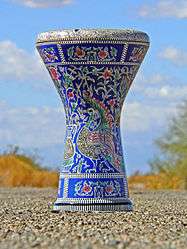Bendir
|
Moroccan bendir with snares | |
| Hornbostel–Sachs classification |
211.3 (Membranophone) |
|---|---|
The Bendir (Arabic: بندير; plural banadir, بنادير is a frame drum.[1] The term Bendir means in Turkish language a big hand frame drum, which is known as Duff in Arabic language. Used as a traditional instrument throughout North Africa. Unlike the tambourine, it has no jingles but most often has a snare (usually made of gut) stretched across its head, which when the drum is struck with the fingers or palm gives the tone a buzzing quality. The bendir is a frame drum with a wooden frame and a membrane. It creates different tones according to the spreading of the shock waves moving across the skins itself. A frame drum is the oldest and most common kind of drum. The bendir is used throughout North Africa, Ancient Egypt, and Mesopotamia. The bendir drum has been around since prehistoric times. The bendir is about 14 to 16 inches. The drum is played kept vertical by inserting the thumb of the left hand in a special holes in the frame. The bandir or bendir is used in the special ceremonies of the Sufi. The Sufi tradition is strongly characterized by the use of music, rhythm, and dance to reach particular states of consciousness. The bendir has a small hole in the bottom, which is used to balance the drum at the base of the left thumb as the left hand fingers that the rim and the right hand plays the rim and center. It is mainly used in the following countries: Morocco, Algeria, Tunisia, Libya and sometimes Egypt. Egypt mostly uses a frame drum similar to the bendir, which is called a tar, except it does not have a snare in the back of it. A version of it exists in Ireland called the Bodhrán which is usually played with a beater.
External links
References and notes
- ↑ Raine-Reusch, Randy (2010). Play the World: The 101 World Instrument Primer. Pacific, MO.: Mel Bay Publications. p. 85. ISBN 978-1-61065-251-3.

